2008 Seat Ibiza 5D refuelling
[x] Cancel search: refuellingPage 6 of 260
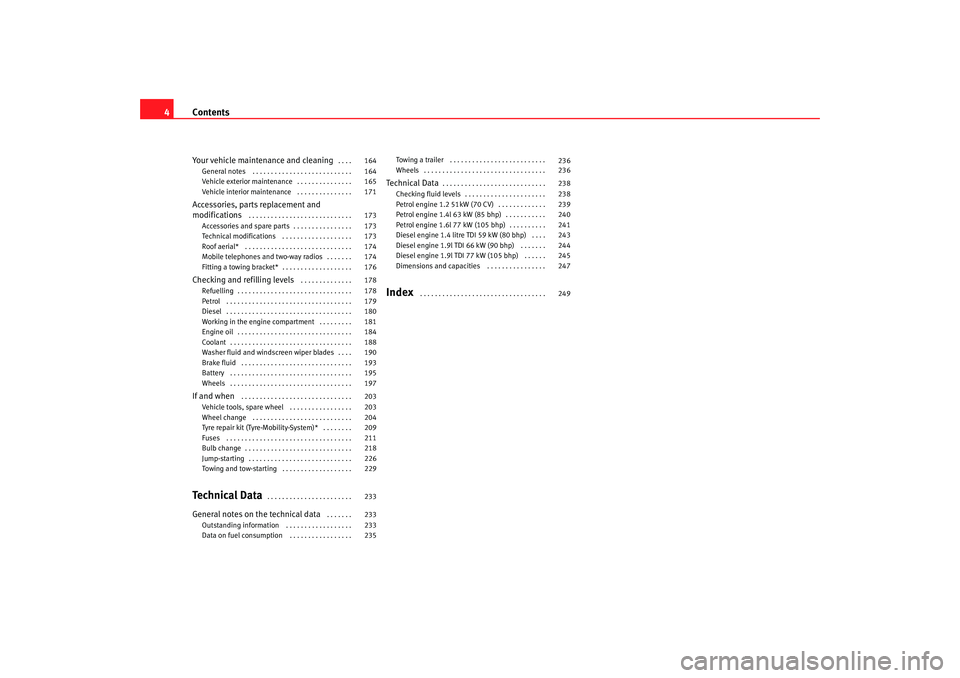
Contents
4Your vehicle maintenance and cleaning
. . . .
General notes . . . . . . . . . . . . . . . . . . . . . . . . . . .
Vehicle exterior maintenance . . . . . . . . . . . . . . .
Vehicle interior maintenance . . . . . . . . . . . . . . .
Accessories, parts replacement and
modifications
. . . . . . . . . . . . . . . . . . . . . . . . . . . .
Accessories and spare parts . . . . . . . . . . . . . . . .
Technical modifications . . . . . . . . . . . . . . . . . . .
Roof aerial* . . . . . . . . . . . . . . . . . . . . . . . . . . . . .
Mobile telephones and two-way radios . . . . . . .
Fitting a towing bracket* . . . . . . . . . . . . . . . . . . .
Checking and refilling levels
. . . . . . . . . . . . . .
Refuelling . . . . . . . . . . . . . . . . . . . . . . . . . . . . . . .
Petrol . . . . . . . . . . . . . . . . . . . . . . . . . . . . . . . . . .
Diesel . . . . . . . . . . . . . . . . . . . . . . . . . . . . . . . . . .
Working in the engine compartment . . . . . . . . .
Engine oil . . . . . . . . . . . . . . . . . . . . . . . . . . . . . . .
Coolant . . . . . . . . . . . . . . . . . . . . . . . . . . . . . . . . .
Washer fluid and windscreen wiper blades . . . .
Brake fluid . . . . . . . . . . . . . . . . . . . . . . . . . . . . . .
Battery . . . . . . . . . . . . . . . . . . . . . . . . . . . . . . . . .
Wheels . . . . . . . . . . . . . . . . . . . . . . . . . . . . . . . . .
If and when
. . . . . . . . . . . . . . . . . . . . . . . . . . . . . .
Vehicle tools, spare wheel . . . . . . . . . . . . . . . . .
Wheel change . . . . . . . . . . . . . . . . . . . . . . . . . . .
Tyre repair kit (Tyre-Mobility-System)* . . . . . . . .
Fuses . . . . . . . . . . . . . . . . . . . . . . . . . . . . . . . . . .
Bulb change . . . . . . . . . . . . . . . . . . . . . . . . . . . . .
Jump-starting . . . . . . . . . . . . . . . . . . . . . . . . . . . .
Towing and tow-starting . . . . . . . . . . . . . . . . . . .
Te c h n i c a l D a t a
. . . . . . . . . . . . . . . . . . . . . . .
General notes on the technical data
. . . . . . .
Outstanding information . . . . . . . . . . . . . . . . . .
Data on fuel consumption . . . . . . . . . . . . . . . . . Towing a trailer . . . . . . . . . . . . . . . . . . . . . . . . . .
Wheels . . . . . . . . . . . . . . . . . . . . . . . . . . . . . . . . .
Techn ical Data
. . . . . . . . . . . . . . . . . . . . . . . . . . . .
Checking fluid levels . . . . . . . . . . . . . . . . . . . . . .
Petrol engine 1.2 51kW (70 CV) . . . . . . . . . . . . .
Petrol engine 1.4l 63 kW (85 bhp) . . . . . . . . . . .
Petrol engine 1.6l 77 kW (105 bhp) . . . . . . . . . .
Diesel engine 1.4 litre TDI 59 kW (80 bhp) . . . .
Diesel engine 1.9l TDI 66 kW (90 bhp) . . . . . . .
Diesel engine 1.9l TDI 77 kW (105 bhp) . . . . . .
Dimensions and capacities . . . . . . . . . . . . . . . .
Index
. . . . . . . . . . . . . . . . . . . . . . . . . . . . . . . . . .
164
164
165
171
173
173
173
174
174
176
178
178
179
180
181
184
188
190
193
195
197
203
203
204
209
211
218
226
229
233
233
233
235 236
236
238
238
239
240
241
243
244
245
247
249
Ibiza250_angles Seite 4 Dienstag, 5. August 2008 1:11 13
Page 135 of 260
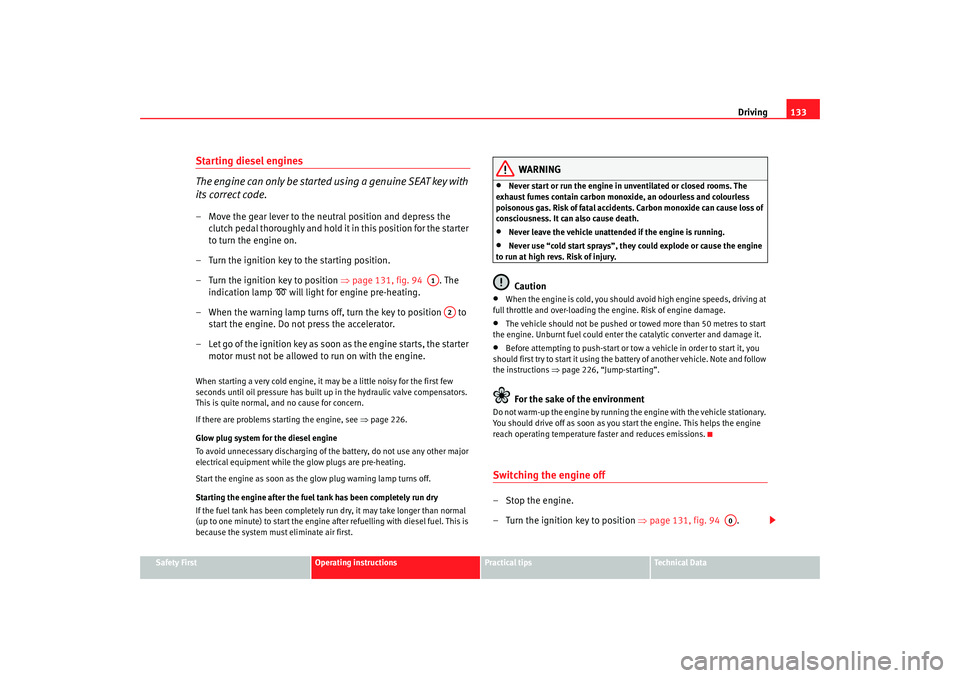
Driving133
Safety First
Operating instructions
Practical tips
Te c h n i c a l D a t a
Starting diesel engines
The engine can only be started using a genuine SEAT key with
its correct code.– Move the gear lever to the ne utral position and depress the
clutch pedal thoroughly and hold it in this position for the starter
to turn the engine on.
– Turn the ignition key to the starting position.
– Turn the ignition key to position ⇒page 131, fig. 94 . The
indication lamp
will light for engine pre-heating.
– When the warning lamp turns off, turn the key to position to start the engine. Do not press the accelerator.
– Let go of the ignition key as soon as the engine starts, the starter motor must not be allowed to run on with the engine.
When starting a very cold engine, it may be a little noisy for the first few
seconds until oil pressure has built up in the hydraulic valve compensators.
This is quite normal, and no cause for concern.
If there are problems starting the engine, see ⇒page 226.
Glow plug system for the diesel engine
To avoid unnecessary discharging of th e battery, do not use any other major
electrical equipment while the glow plugs are pre-heating.
Start the engine as soon as the glow plug warning lamp turns off.
Starting the engine after the fuel tank has been completely run dry
If the fuel tank has been completely ru n dry, it may take longer than normal
(up to one minute) to start the engine af ter refuelling with diesel fuel. This is
because the system must eliminate air first.
WARNING
•
Never start or run the engine in unventilated or closed rooms. The
exhaust fumes contain carbon mono xide, an odourless and colourless
poisonous gas. Risk of fatal accidents. Carbon monoxide can cause loss of
consciousness. It can also cause death.
•
Never leave the vehicle unattended if the engine is running.
•
Never use “cold start sprays”, they could explode or cause the engine
to run at high revs. Risk of injury.Caution
•
When the engine is cold, you should avoid high engine speeds, driving at
full throttle and over-loading the engine. Risk of engine damage.
•
The vehicle should not be pushed or towed more than 50 metres to start
the engine. Unburnt fuel could enter th e catalytic converter and damage it.
•
Before attempting to push-start or tow a vehicle in order to start it, you
should first try to start it using the batt ery of another vehicle. Note and follow
the instructions ⇒page 226, “Jump-starting”.For the sake of the environment
Do not warm-up the engine by running th e engine with the vehicle stationary.
You should drive off as soon as you start the engine. This helps the engine
reach operating temperature faster and reduces emissions.Switching the engine off– Stop the engine.
– Turn the ignition key to position ⇒page 131, fig. 94 .
A1
A2
A0
Ibiza250_angles Seite 133 Dienstag, 5. August 2008 1:11 13
Page 159 of 260
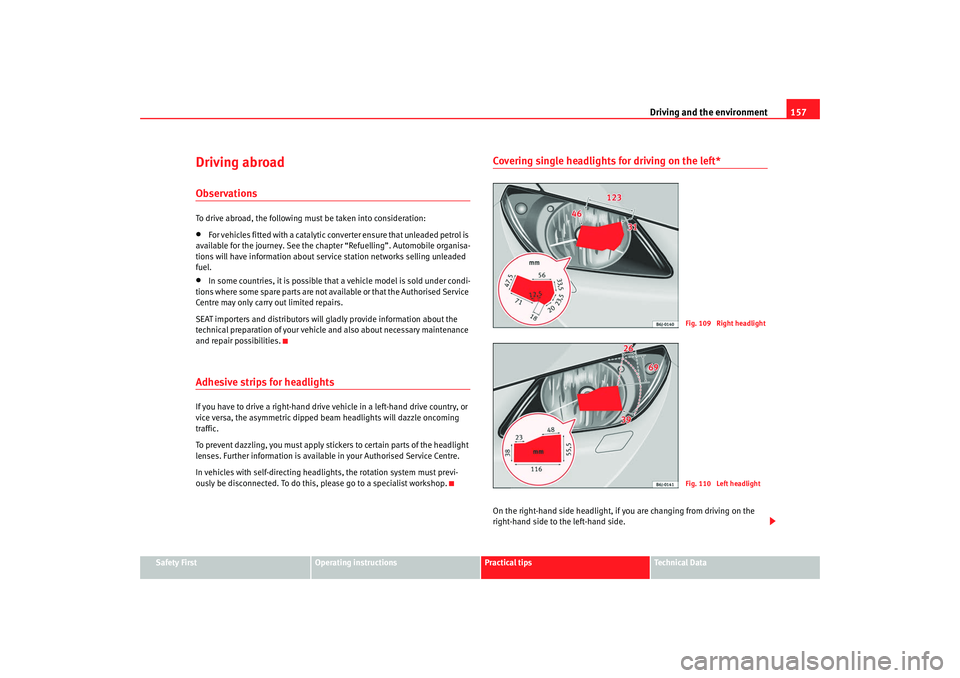
Driving and the environment157
Safety First
Operating instructions
Practical tips
Te c h n i c a l D a t a
Driving abroadObservationsTo drive abroad, the following must be taken into consideration:•
For vehicles fitted with a catalytic converter ensure that unleaded petrol is
available for the journey. See the chapter “Refuelling”. Automobile organisa-
tions will have information about service station networks selling unleaded
fuel.
•
In some countries, it is possible that a vehicle model is sold under condi-
tions where some spare parts are not available or that the Authorised Service
Centre may only carry out limited repairs.
SEAT importers and distributors will gladly provide information about the
technical preparation of your vehicle and also about necessary maintenance
and repair possibilities.
Adhesive strips for headlightsIf you have to drive a right-hand drive vehicle in a left-hand drive country, or
vice versa, the asymmetric dipped beam headlights will dazzle oncoming
traffic.
To prevent dazzling, you must apply stickers to certain parts of the headlight
lenses. Further information is available in your Authorised Service Centre.
In vehicles with self-directing headlights, the rotation system must previ-
ously be disconnected. To do this, please go to a specialist workshop.
Covering single headlights for driving on the left*On the right-hand side headlight, if you are changing from driving on the
right-hand side to the left-hand side.
Fig. 109 Right headlightFig. 110 Left headlight
Ibiza250_angles Seite 157 Dienstag, 5. August 2008 1:11 13
Page 180 of 260
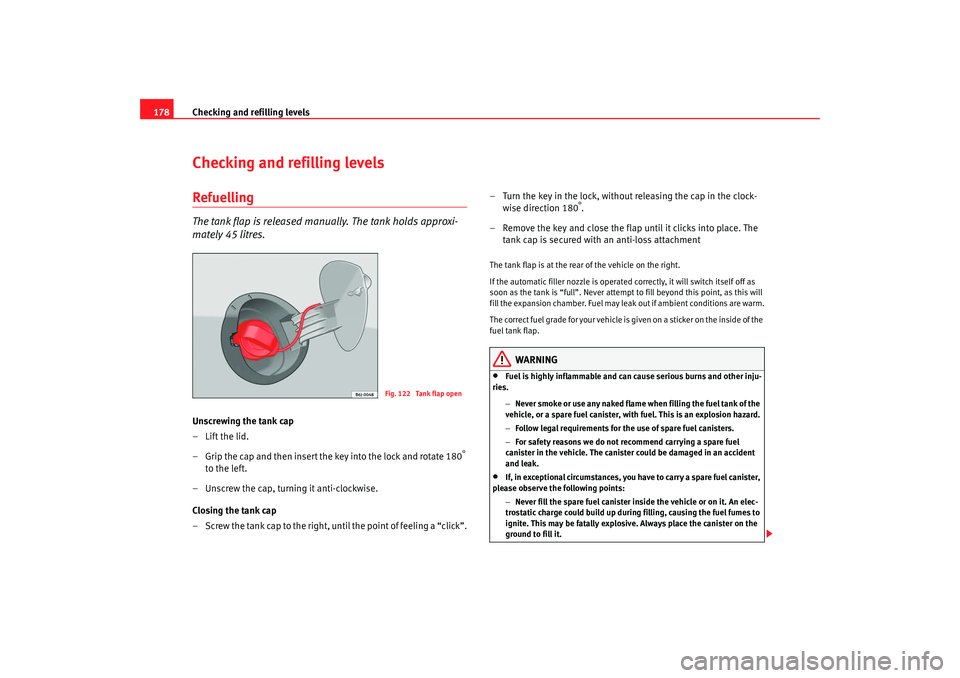
Checking and refilling levels
178Checking and refilling levelsRefuellingThe tank flap is released manually. The tank holds approxi-
mately 45 litres.Unscrewing the tank cap
–Lift the lid.
– Grip the cap and then insert the key into the lock and rotate 180
°
to the left.
– Unscrew the cap, turning it anti-clockwise.
Closing the tank cap
– Screw the tank cap to the right, until the point of feeling a “click”. – Turn the key in the lock, without releasing the cap in the clock-
wise direction 180
°.
– Remove the key and close the flap until it clicks into place. The tank cap is secured with an anti-loss attachment
The tank flap is at the rear of the vehicle on the right.
If the automatic filler nozzle is operated correctly, it will switch itself off as
soon as the tank is “full”. Never attempt to fill beyond this point, as this will
fill the expansion chamber. Fuel may leak out if ambient conditions are warm.
The correct fuel grade for your vehicle is given on a sticker on the inside of the
fuel tank flap.
WARNING
•
Fuel is highly inflammable and can cause serious burns and other inju-
ries.
−Never smoke or use any naked flame when filling the fuel tank of the
vehicle, or a spare fuel canister, with fuel. This is an explosion hazard.
− Follow legal requirements for the use of spare fuel canisters.
− For safety reasons we do not recommend carrying a spare fuel
canister in the vehicle. The canister could be damaged in an accident
and leak.
•
If, in exceptional circumstances, you have to carry a spare fuel canister,
please observe the following points:
−Never fill the spare fuel canister inside the vehicle or on it. An elec-
trostatic charge could build up during filling, causing the fuel fumes to
ignite. This may be fatally explosive. Always place the canister on the
ground to fill it.
Fig. 122 Tank flap open
Ibiza250_angles Seite 178 Dienstag, 5. August 2008 1:11 13
Page 181 of 260
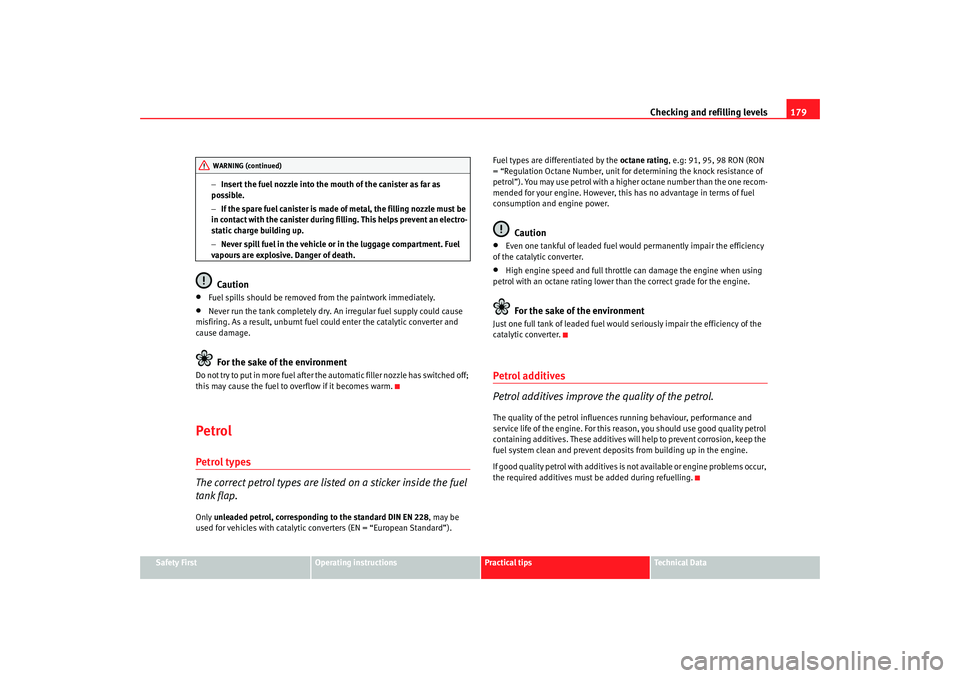
Checking and refilling levels179
Safety First
Operating instructions
Practical tips
Te c h n i c a l D a t a
−
Insert the fuel nozzle into the mouth of the canister as far as
possible.
− If the spare fuel canister is made of metal, the filling nozzle must be
in contact with the canister during filling. This helps prevent an electro-
static charge building up.
− Never spill fuel in the vehicle or in the luggage compartment. Fuel
vapours are explosive. Danger of death.
Caution
•
Fuel spills should be removed from the paintwork immediately.
•
Never run the tank completely dry. An irregular fuel supply could cause
misfiring. As a result, unburnt fuel co uld enter the catalytic converter and
cause damage.For the sake of the environment
Do not try to put in more fuel after the automatic filler nozzle has switched off;
this may cause the fuel to overflow if it becomes warm.PetrolPetrol types
The correct petrol types are listed on a sticker inside the fuel
tank flap.Only unleaded petrol, corresponding to the standard DIN EN 228 , may be
used for vehicles with catalytic conv erters (EN = “European Standard”). Fuel types are differentiated by the
octane rating, e.g: 91, 95, 98 RON (RON
= “Regulation Octane Number, unit for determining the knock resistance of
petrol”). You may use petrol with a higher octane number than the one recom-
mended for your engine. However, this has no advantage in terms of fuel
consumption and engine power.
Caution
•
Even one tankful of leaded fuel would permanently impair the efficiency
of the catalytic converter.
•
High engine speed and full throttle can damage the engine when using
petrol with an octane rating lower than the correct grade for the engine.For the sake of the environment
Just one full tank of leaded fuel would seriously impair the efficiency of the
catalytic converter.Petrol additives
Petrol additives improve the quality of the petrol.The quality of the petrol influences running behaviour, performance and
service life of the engine. For this reason, you should use good quality petrol
containing additives. These additives will help to prevent corrosion, keep the
fuel system clean and prevent deposits from building up in the engine.
If good quality petrol with additives is not available or engine problems occur,
the required additives must be added during refuelling.
WARNING (continued)
Ibiza250_angles Seite 179 Dienstag, 5. August 2008 1:11 13
Page 255 of 260
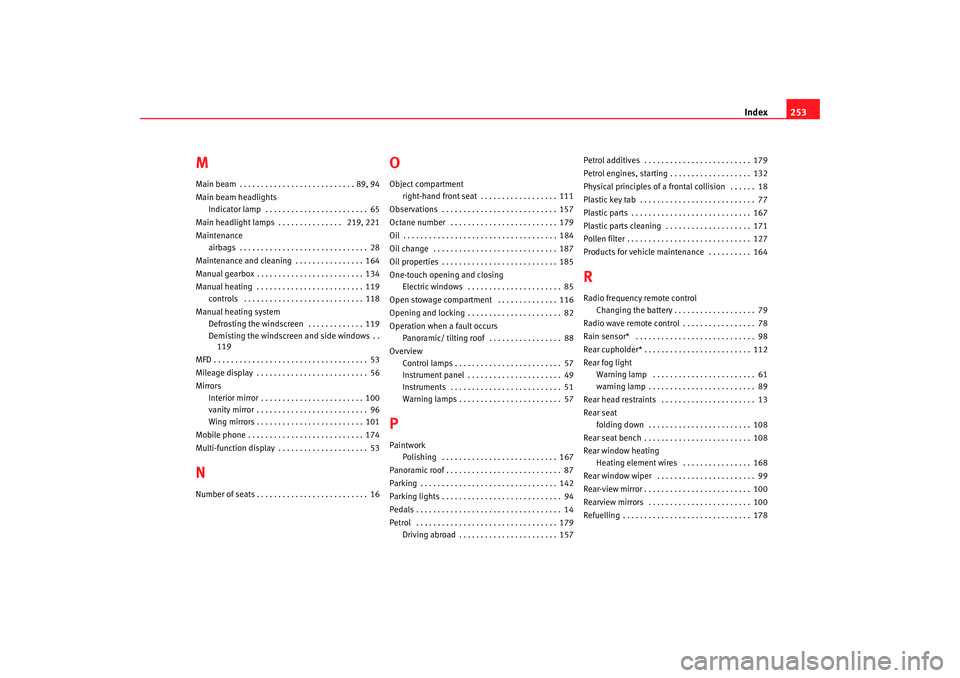
Index253
MMain beam . . . . . . . . . . . . . . . . . . . . . . . . . . . 89, 94
Main beam headlights
Indicator lamp . . . . . . . . . . . . . . . . . . . . . . . . 65
Main headlight lamps . . . . . . . . . . . . . . . 219, 221
Maintenance airbags . . . . . . . . . . . . . . . . . . . . . . . . . . . . . . 28
Maintenance and cleaning . . . . . . . . . . . . . . . . 164
Manual gearbox . . . . . . . . . . . . . . . . . . . . . . . . . 134
Manual heating . . . . . . . . . . . . . . . . . . . . . . . . . 119 controls . . . . . . . . . . . . . . . . . . . . . . . . . . . . 118
Manual heating system Defrosting the windscreen . . . . . . . . . . . . . 119
Demisting the windscreen and side windows . .119
MFD . . . . . . . . . . . . . . . . . . . . . . . . . . . . . . . . . . . . 53
Mileage display . . . . . . . . . . . . . . . . . . . . . . . . . . 56
Mirrors Interior mirror . . . . . . . . . . . . . . . . . . . . . . . . 100
vanity mirror . . . . . . . . . . . . . . . . . . . . . . . . . . 96
Wing mirrors . . . . . . . . . . . . . . . . . . . . . . . . . 101
Mobile phone . . . . . . . . . . . . . . . . . . . . . . . . . . . 174
Multi-function display . . . . . . . . . . . . . . . . . . . . . 53NNumber of seats . . . . . . . . . . . . . . . . . . . . . . . . . . 16
OObject compartment right-hand front seat . . . . . . . . . . . . . . . . . . 111
Observations . . . . . . . . . . . . . . . . . . . . . . . . . . . 157
Octane number . . . . . . . . . . . . . . . . . . . . . . . . . 179
Oil . . . . . . . . . . . . . . . . . . . . . . . . . . . . . . . . . . . . 184
Oil change . . . . . . . . . . . . . . . . . . . . . . . . . . . . . 187
Oil properties . . . . . . . . . . . . . . . . . . . . . . . . . . . 185
One-touch opening and closing Electric windows . . . . . . . . . . . . . . . . . . . . . . 85
Open stowage compartment . . . . . . . . . . . . . . 116
Opening and locking . . . . . . . . . . . . . . . . . . . . . . 82
Operation when a fault occurs Panoramic/ tilt ing roof . . . . . . . . . . . . . . . . . 88
Overview Control lamps . . . . . . . . . . . . . . . . . . . . . . . . . 57
Instrument panel . . . . . . . . . . . . . . . . . . . . . . 49
Instruments . . . . . . . . . . . . . . . . . . . . . . . . . . 51
Warning lamps . . . . . . . . . . . . . . . . . . . . . . . . 57PPaintworkPolishing . . . . . . . . . . . . . . . . . . . . . . . . . . . 167
Panoramic roof . . . . . . . . . . . . . . . . . . . . . . . . . . . 87
Parking . . . . . . . . . . . . . . . . . . . . . . . . . . . . . . . . 142
Parking lights . . . . . . . . . . . . . . . . . . . . . . . . . . . . 94
Pedals . . . . . . . . . . . . . . . . . . . . . . . . . . . . . . . . . . 14
Petrol . . . . . . . . . . . . . . . . . . . . . . . . . . . . . . . . . 179 Driving abroad . . . . . . . . . . . . . . . . . . . . . . . 157 Petrol additives . . . . . . . . . . . . . . . . . . . . . . . . . 179
Petrol engines, starting . . . . . . . . . . . . . . . . . . . 132
Physical principles of a frontal collision . . . . . . 18
Plastic key tab . . . . . . . . . . . . . . . . . . . . . . . . . . . 77
Plastic parts . . . . . . . . . . . . . . . . . . . . . . . . . . . . 167
Plastic parts cleaning . . . . . . . . . . . . . . . . . . . . 171
Pollen filter . . . . . . . . . . . . . . . . . . . . . . . . . . . . . 127
Products for vehicle maintenance . . . . . . . . . . 164
RRadio frequency remote control
Changing the battery . . . . . . . . . . . . . . . . . . . 79
Radio wave remote control . . . . . . . . . . . . . . . . . 78
Rain sensor* . . . . . . . . . . . . . . . . . . . . . . . . . . . . 98
Rear cupholder* . . . . . . . . . . . . . . . . . . . . . . . . . 112
Rear fog light Warning lamp . . . . . . . . . . . . . . . . . . . . . . . . 61
warning lamp . . . . . . . . . . . . . . . . . . . . . . . . . 89
Rear head restraints . . . . . . . . . . . . . . . . . . . . . . 13
Rear seat folding down . . . . . . . . . . . . . . . . . . . . . . . . 108
Rear seat bench . . . . . . . . . . . . . . . . . . . . . . . . . 108
Rear window heating Heating element wires . . . . . . . . . . . . . . . . 168
Rear window wiper . . . . . . . . . . . . . . . . . . . . . . . 99
Rear-view mirror . . . . . . . . . . . . . . . . . . . . . . . . . 100
Rearview mirrors . . . . . . . . . . . . . . . . . . . . . . . . 100
Refuelling . . . . . . . . . . . . . . . . . . . . . . . . . . . . . . 178
Ibiza250_angles Seite 253 Dienstag, 5. August 2008 1:11 13